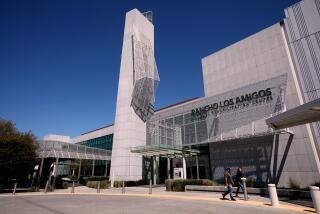Review: ‘Code Black’ a riveting doctor’s-eye view of the emergency room
- Share via
Anyone who has spent time in an emergency room, regardless of the hospital, knows it can be an exercise in frustration, confusion and Kafka-like bureaucracy, along with the physical and emotional strain of whatever put you there in the first place.
The documentary “Code Black” portrays the experience of an emergency room from a perspective many of us otherwise might not know, directed by Ryan McGarry when he was a young doctor at Los Angeles County-USC Medical Center.
The time frame of the film, 2008 to 2012, places it outside the specifics of the Affordable Care Act debate but very much within the framework of the crisis in healthcare. One doctor refers to the hospital as the “front door” for the county, meaning it takes anyone who passes through, including those turned away from other facilities.
The film starts with the doctors at the old county hospital, where modern emergency room procedures were partly born but had become so outdated that the facility was exempt from following many modern guidelines. So when the doctors move to a newer facility, one with both patient privacy and piles of paperwork, they feel constricted in their work. Much of the film deals with McGarry and his fellow doctors navigating their new world between the immediacy of their old ways and updated regulations.
The film has extremely graphic footage, grisly even just in glimpses, which gives a sense of the chaos under which these doctors function even in the best of circumstances. The film’s title refers to the emergency room being at or past capacity, and the shifts in intensity and volume of patients can be punishing. The wistful drunk singing a love song in Spanish and the patient suffering a psychotic breakdown and convinced nurses are trying to kill him — they’re all in a day’s work.
The film feels like neither a polemic, a reality show pilot nor some kind of soap opera doctor drama. (This is for the best.) Though a number of the doctors are rather improbably good-looking, the focus is very much on their work at the hospital as they move from naïve newbies to tried-and-tested veterans themselves, while thankfully retaining a sense of earnest commitment.
The movie won the documentary prize when it premiered at the 2013 Los Angeles Film Festival. The film was shot with a relatively upscale camera, and the imagery and construction are more polished and structured than one might expect from a largely fly-on-the-wall production. Part of what makes “Code Black” so exciting is that it may be one of the best examples of the new possibilities of the age of digital filmmaking. The press notes for the film mention that McGarry is based at a hospital in New York City while developing scripted projects, but whether he makes another film is in some sense irrelevant. McGarry has created something that feels personal, vital and revelatory, allowing the rest of us behind the curtain.
Twitter: @IndieFocus
More to Read
Only good movies
Get the Indie Focus newsletter, Mark Olsen's weekly guide to the world of cinema.
You may occasionally receive promotional content from the Los Angeles Times.











